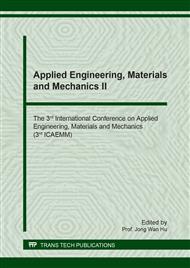[1]
M. Kimura, K. Nakamura, K. Tsutsumi, Surface free energies of silica fillers and their relation to the adsorption of poly(ethylene terephthalate), J. Coll. Interf. Sci. 279 (2004) 509–514.
DOI: 10.1016/j.jcis.2004.06.093
Google Scholar
[2]
S. Y. Hwang, W. D. Lee, J. S. Lim, K. H. Park, S. S. Im, Dispersibility of clay and crystallization kinetics for in situ polymerized PET/pristine and modified montmorillonite nanocomposites, J. Polym. Sci. Part B: Polym. Phys. 46 (2008) 1022–1035.
DOI: 10.1002/polb.21435
Google Scholar
[3]
N. Torres, J. J. Robin, B. Boutevin, Study of thermal and mechanical properties of virgin and recycled poly(ethylene terephthalate) before and after injection molding, Eur. Polym. J. 36 (2000) 2075–(2080).
DOI: 10.1016/s0014-3057(99)00301-8
Google Scholar
[4]
G. Güçlü, T. Yalçınyuva, S. Özgümüş, M. Orbay, Hydrolysis of waste polyethylene terephthalate and characterization of products by differential scanning calorimetry, Thermochim. Acta 404 (2003) 193–205.
DOI: 10.1016/s0040-6031(03)00160-6
Google Scholar
[5]
A. J. J. E. Eerhart, A. P. C. Faaij, M. K. Patel, Replacing fossil based PET with biobased PEF; process analysis, energy and GHG balance, Energy Environ. Sci. 5 (2012) 6407–6422.
DOI: 10.1039/c2ee02480b
Google Scholar
[6]
V. Tsanaktsis, E. Vouvoudi, G. Z. Papageorgiou, D. G. Papageorgiou, K. Chrissafis, D. N. Bikiaris, Thermal degradation kinetics and decomposition mechanism of polyesters based on 2,5-furandicarboxylic acid and low molecular weight aliphatic diols, J. Anal. Appl. Pyrolysis 112 (2015).
DOI: 10.1016/j.jaap.2014.12.016
Google Scholar
[7]
A. F. Sousa, C. Vilela, A. C. Fonseca, M. Matos, C. S. R. Freire, G. -J. M. Gruter, J. F. J. Coelho, A. J. D. Silvestre, Biobased polyesters and other polymers from 2,5-furandicarboxylic acid: a tribute to furan excellency, Polym. Chem. 6 (2015).
DOI: 10.1039/c5py00686d
Google Scholar
[8]
T. Kim, J. M. Koo, M. H. Ryu, H. Jeon, S. M. Kim, S. A. Park, D. X. Oh, J. Park, S. Y. Hwang, Sustainable terpolyester of high Tg based on bio heterocyclic monomer of dimethyl furan-2,5-dicarboxylate and isosorbide, Polymer 132 (2017) 122–132.
DOI: 10.1016/j.polymer.2017.10.052
Google Scholar
[9]
S. K. Burgess, R. M. Kriegel, W. J. Koros, Carbon dioxide sorption and transport in amorphous poly(ethylene furanoate), Macromolecules 48 (2015) 2184−2193.
DOI: 10.1021/acs.macromol.5b00333
Google Scholar
[10]
J. Wang, X. Liu, Y. Zhang, F. Liu, J. Zhu, Modification of poly(ethylene 2,5-furandicarboxylate) with 1,4-cyclohexanedimethylene: influence of composition on mechanical and barrier properties, Polymer 103 (2016) 1–8.
DOI: 10.1016/j.polymer.2016.09.030
Google Scholar
[11]
J. Zhu, J. Cai, W. Xie, P. H. Chen, M. Gazzano, M. Scandola, R. A. Gross, Poly(butylene 2,5-furan dicarboxylate), a biobased alternative to PBT: synthesis, physical properties, and crystal structure, Macromolecules 46 (2013) 796−804.
DOI: 10.1021/ma3023298
Google Scholar
[12]
S. K. Burgess, J. E. Leisen, B. E. Kraftschik, C. R. Mubarak, R. M. Kriegel, W. J. Koros, Chain mobility, thermal, and mechanical properties of poly(ethylene furanoate) compared to poly(ethylene terephthalate), Macromolecules 47 (2014) 1383−1391.
DOI: 10.1021/ma5000199
Google Scholar
[13]
K. S. Walton, M. B. Abney, M. D. LeVan, CO2 adsorption in Y and X zeolites modified by alkali metal cation exchange, Micropor. Mesopor. Mater. 91 (2006) 78–84.
DOI: 10.1016/j.micromeso.2005.11.023
Google Scholar
[14]
J. G. van Berkel, N. Guigo, J. J. Kolstad, L. Sipos, B. Wang, M. A. Dam, N. Sbirrazzuoli, Isothermal crystallization kinetics of poly(ethylene 2,5-furandicarboxylate), Macromol. Mater. Eng. 300 (2015) 466–474.
DOI: 10.1002/mame.201400376
Google Scholar
[15]
V. Tsanaktsis, D. N. Bikiaris, N. Guigo, S. Exarhopoulos, D. G. Papageorgiou, N. Sbirrazzuoli, G. Z. Papageorgiou, Synthesis, properties and thermal behavior of poly(decylene-2,5-furanoate): a biobased polyester from 2,5-furan dicarboxylic acid, RSC Adv. 5 (2015).
DOI: 10.1039/c5ra13324f
Google Scholar


